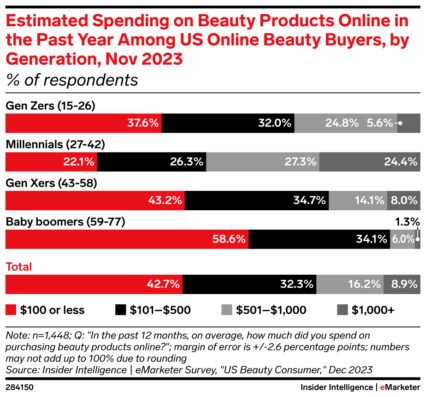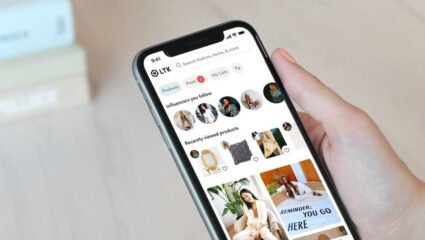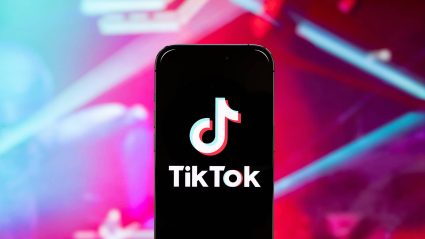From the days of beauty YouTubers giving tutorials on the perfect 2016 Dipbrow to teen TikTokers recommending the latest K-beauty products on TikTok Shop, beauty-related content has long been a major force on social media.
Beauty brands have long taken advantage of the buzz around new trends and products by forging partnerships with influencers, but those tactics have evolved over time as social media platforms rise and fall (goodbye Vine; hello TikTok) and trend cycles pick up speed.
On the cutting edge of social media culture is Gen Z–young adults born between 1997 and 2012. As the first digital natives, these shoppers are tech-savvy and wise to marketers’ tricks when it comes to social media. Brands looking to win these young consumers need to adapt quickly to new platforms, capitalize on the latest trends, and get just the right tone to fit in with other content (and never sound “cringe”).
Marketing to Gen Z on social media
Gen Z is already a valuable segment of the beauty market, and the generation will only become more important over time as their buying power increases. More than half (62%) of Gen Z consumers shop for beauty items online at least once a month, and in 2023 almost a quarter (24.8%) said they spent $501-$1000 in the last year, according to eMarketer.

Source: eMarketer
One of the best ways to tap into the generation’s spending potential is via social media, particularly through partnering with influencers on apps like TikTok, YouTube, or even Pinterest.
Gen Z is well-represented across social media platforms, but especially on their favorite app, TikTok–76.2% of US users aged 18-24 use TikTok, while only 54% of 25-34-year-olds use the app.
According to LTK, almost 80% of Gen Z women said creators were the source they trusted most for beauty recommendations. This may be partly because Gen Zers value authenticity and connection, which their favorite online creators can provide with product suggestions based on their own experiences.
What sets Gen Z apart from other generations online
Gen Z marches to the beat of its own drum when it comes to social media–and brands looking to win their dollars will need to adapt their marketing strategies to reach them.
A key aspect of marketing to Gen Z is keeping up with the generation’s rapid trend cycles. While older generations followed slower cycles in the past, Gen Z is quick to notice creator-vetted products burning up their feeds and update their buying accordingly. For example, beauty dupes can spread lightning-fast on TikTok, leading Gen Zers to switch their purchase plans to cheaper options.
But even dupes need to make a splash to get Gen Z to pay attention. MCoBeauty, an Australian brand known for its dupes of high-end products, leverages that trend to its advantage; when the brand saw the poster for a Timothée Chalamet lookalike contest in New York, they jumped on the event. They partnered with an influencer known for his resemblance to the actor and sent him to the contest, bringing their brand into the conversation as lookalike competitions spread across the US and the internet.

Source: AdAge
This partnership was only possible because the brand worked proactively and was one of the first to respond to this new trend. To succeed in today’s fast-paced world, marketers have to keep a close eye on their audience’s online communities and listen carefully for changes in language and new expectations. But that won’t be enough–they also need to respond quickly before the trends inevitably go out of style.
The challenges don’t stop there: even if brands get Gen Z shoppers’ attention, there’s no guarantee they can keep it for long. Gen Z is less brand-loyal than older generations. These young adults grew up facing tough economic circumstances like the rising cost of living, so they’re price-conscious. They’re willing to switch from one brand to another if they find better deals.
They also care about social causes like climate change. Because they’re constantly receiving new information online, they’re quick to notice mistakes brands make, and they won’t hesitate to leave them behind if they aren’t aligning with their values and priorities.
Leveraging influencers to your advantage as a beauty brand
To attract–and keep–Gen Z audiences’ attention, brands need to adjust their social media strategies to fit the way young adults use online platforms.
1. Keep your ear to the ground: social listening and speaking Gen Z’s language
Marketing to Gen Z is all about staying on top of trends. To do that, you need to keep up with the latest news. It’s crucial to have a solid social listening strategy in place, not just so you can watch your customers’ conversations, but so you can create relatable content and build strong relationships with your audience.
Gen Zers often gather in niche online communities. If you can find which ones align with your target audience, you know where to reach your customers. You can then align your messaging with these interest groups on social media and target users there–but you need to be careful.
It’s key to use the right tone, language, and ideas for the particular space you’re marketing to. These communities have specific ways of talking, so it’s easy for users to see through inauthentic marketing if a post feels “off” or disrupts their experience. In the best-case scenario, mistakes like this can make users cringe, but they can also cause these communities to lose trust in your brand.
If Gen Z is a key demographic for your brand, it’s also a good idea to make sure you have some team members who understand their priorities and language. Listening to your Gen Z marketing employees’ takes can help you stay in the know and keep on top of even the weirdest TikTok trends.
@her.one.official 🧿👄🧿 another day another slay queen #queennevercry #meme #fyp #trending
2. Think fast: jump on trends with the help of influencer and creator partners
It’s not enough just to hear about trends; you need to act quickly to make sure you leverage them before it’s too late. Quick cycles mean you don’t have much time to act before a trend is over the hill, so the faster you can respond, the better.
Your team needs to have a process in place to fast-track content ideas that rely on timely topics. If your creative gets stuck under layers of approvals, it often will be useless by the time it’s been reviewed–so make sure your team knows your brand guidelines and who can take a look quickly to make production more efficient.
You can also keep influencers on deck to help you respond quickly. If you have an established brand relationship with an influencer in a target community, you can use their knowledge to your advantage by getting them to create relevant content for you.
3. Follow the leader: let influencers show you the way
We all know influencers can help brands create content, but they can also play a bigger role in your team’s social media marketing. Influencers know their audiences best, so they can act as your guide to the communities you’re targeting.
Start by making sure you have the perfect partners in your team’s arsenal. To build a great relationship with online creators and get the most out of working with them, you need to choose influencers who align with your brand’s values and truly appreciate your product. If you’re working with someone who doesn’t really love or use your brand, their sponsored posts may ring false to their followers.
Once those relationships are in place, take advantage of their expertise and their signature style of content. Set clear parameters for what you want in sponsored content, but give them the freedom to put their own twist on those ideas so the content feels authentic to their feed. If you’re working with an influencer with an established audience, look to learn more about that community from the inside out and how your brand can resonate beyond a specific post.
If you want to take things a step further, influencers can do even more by serving as brand consultants. That can involve anything from a basic level of collaboration on just one campaign to a more involved role where an influencer consults on the actual making of a product or service, like Rhode’s recent partnership with influencer Matilda Djerf to create a peppermint-flavored lip balm.
If you’re feeling overwhelmed by the fast pace of new creator trends, you’re not alone–trying to keep up with social media these days can feel like running on a hamster wheel.
But with the right process and the right partnerships, your social media can strike just the right tone to appeal to your Gen Z audience.







Responses